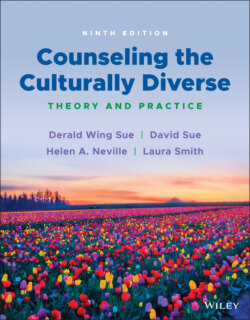Читать книгу Counseling the Culturally Diverse - Laura Smith L. - Страница 78
Paralanguage
ОглавлениеThe term paralanguage refers to vocal cues that individuals use to add meaning to their communications. For example, loudness of voice, pauses, silences, hesitations, rate of speech, inflections, and the like all fall into this category. Paralanguage is likely to be manifested forcefully in conversational conventions such as how we greet and address others and how we take turns in speaking. It can communicate a variety of different features about a person, such as their age, gender, sex, race, and emotional responses.
There are complex cultural rules regarding when to speak and when to yield to another. For example, European Americans frequently feel uncomfortable with a pause or silent stretch in the conversation and feel obligated to fill it with more talk. However, other cultures interpret it differently, and silence is not always a sign for the listener to take up the conversation. The British and Arabs use silence for privacy, while the Russians, French, and Spanish may read it as agreement among the parties (Hall, 1976). In Asian cultures, silence is traditionally a sign of respect for elders. Furthermore, silence by many Chinese and Japanese is not a floor‐yielding signal inviting others to pick up the conversation. Rather, it may indicate a desire to continue speaking after making a particular point. Silence, therefore, is a sign of politeness and respect rather than a lack of desire to continue speaking. A mental health professional who is uncomfortable with silence or who misinterprets it may jump into fill the silence and thereby prevent the client from elaborating. An even greater danger is to impute incorrect motives to the minority client's silence. One can readily see how therapy, which emphasizes talking, may place many members of marginalized cultural groups at a disadvantage.
Volume and intensity of speech in conversation are also influenced by cultural values. The overall loudness of speech displayed by many European American visitors to foreign countries has earned them the reputation of being boisterous and overbearing. In Asian countries, people tend to speak more softly and may interpret the loud volume of a U.S. visitor as a sign of aggressiveness, loss of self‐control, or anger. A therapist or counselor would be well advised to be aware of possible cultural misinterpretations as a function of speech volume. Speaking loudly may not indicate anger and hostility, and speaking in a soft voice may not be a sign of weakness, shyness, or depression—all these paralanguage cues are culturally‐bound.
The directness of a conversation or the degree of frankness also varies considerably among various cultural groups. Observing the British in their parliamentary debates will drive this point home. The long British heritage of open, direct, and frank confrontation leads to heckling of public speakers and exchanges that may seem blunt and sharp to American viewers. Britons believe and feel that these are acceptable styles and may take no offense at being the object of such exchanges. Relative to Asian Americans, however, European Americans are seen as being too blunt and frank. Great care is taken by many Asian Americans not to hurt others’ feelings or embarrass them. As a result, use of euphemisms and ambiguity is the norm. Since many groups of color may value indirectness, the U.S. emphasis on “getting to the point” and “not beating around the bush” may alienate them. Asian Americans, American Indians, and some Latinx Americans can all see this behavior as immature, rude, and lacking in finesse. On the other hand, they may find themselves negatively labeled as evasive and/or afraid to confront a problem.
